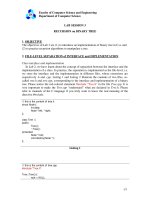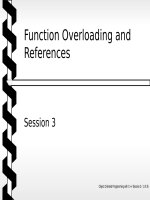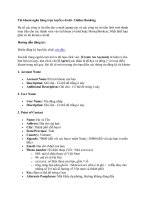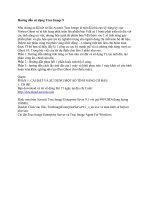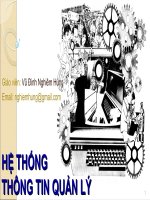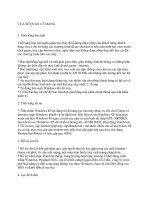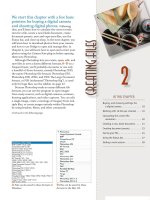Computer Hardware & Software - Session 3 pps
Bạn đang xem bản rút gọn của tài liệu. Xem và tải ngay bản đầy đủ của tài liệu tại đây (259.83 KB, 45 trang )
Data Representation in Computers/Session 3 / 1 of 45
Data Representation in
Computers
Session 3
Data Representation in Computers/Session 3 / 2 of 45
Session Objectives
■
Describe what a Number system is
■
Explain the decimal, octal and hexadecimal
number systems
■
Convert a number from one number system
to another
■
Practice binary arithmetic
■
List the various standard codes used to
represent the unit of information
–
ASCII
–
EBCDIC
Data Representation in Computers/Session 3 / 3 of 45
Session Objectives (Contd.)
■
Explain Data Representation
■
Explain Data Storage
■
Explain Packed Decimal
■
Binary Arithmetic Calculation
■
Explain CPU and its speed
Data Representation in Computers/Session 3 / 4 of 45
Number
systems
■
The additive approach - Number
earlier consisted of symbols e.g.
Roman number system - I for 1,
II for 2, III for 3 etc.
■
Positional numbering - Symbols
represent different values depending
on the position they occupy e.g. the
Decimal system
Data Representation in Computers/Session 3 / 5 of 45
Decimal Number System
■
In the decimal number system the
successive position to the left of
the decimal point represent units,
tens, hundreds, thousands etc.
■
(3 * 100) + (6*10) + (5*1) = 365
■
The position of the number affects
its value.
■
These kind of number systems
therefore are called positional
number system.
Base
Position number
(6*10)
Data Representation in Computers/Session 3 / 6 of 45
Decimal Number System
(Contd.)
■
The value of each digit in the
number system is determined by:
a) The digit itself
b) The position of the digit
in the number
c) The base/radix of the system
Data Representation in Computers/Session 3 / 7 of 45
Binary Number System
■
The binary number system has a base of two
and symbols used are 0 and 1.
■
In this number system, as we move to the left,
the value of the digit will be two times greater
than its predecessor because the base is two.
■
Thus the value of the places are :
■
64 32 16 8 4 2 1
0001111001010111
Least Significant bit Most Significant bit
Binary Number
Data Representation in Computers/Session 3 / 8 of 45
Octal number
systems
Binary Octal
000 0
001 1
010 2
011 3
100 4
101 5
110 6
111 7
■
Uses a base of 8
■
Values increase
■
from right to left
1, 8, 64, 512
Data Representation in Computers/Session 3 / 9 of 45
Octal Number System
■
The octal system has the base of 8. The value
increase from right to left as 1, 8, 64, 512,
4096.
■
The decimal value of an octal number 1204 can
be computed as :
1204 = (1 * 512) + (2 * 64) + (0 * 8) + (4 * 1)
= 512 + 128 + 0 + 4
= 644
Data Representation in Computers/Session 3 / 10 of 45
Octal Number System
Binary Octal
0000
0011
0102
0113
100 4
1015
110 6
111 7
To convert a number from binary to octal and vice
versa, the following table must be kept in mind:
Data Representation in Computers/Session 3 / 11 of 45
Hexadecimal Number
Systems
Hexadecimal Decimal
0 0
1 1
2 2
3 3
4 4
5 5
6 6
7 7
8 8
9 9
A 10
B 11
C 12
D 13
E 14
F 15
Data Representation in Computers/Session 3 / 12 of 45
Hex. Number
Systems(Contd.)
■
Uses a base of 16
■
The 16 symbols required for the
hexadecimal number system obtained
by using the alphabets A, B, C,
D, E and F
■
Converting hexadecimal to decimal
decimal equivalent of a hexadecimal
number A0119
(10 * 65,536)+(0 * 4,096)+(1 * 256)+
( 1 * 16) + ( 9 * 1)
= 6,55,360 + 0 + 256 + 16 + 9
= 6, 55, 641
Data Representation in Computers/Session 3 / 13 of 45
Converting binary numbers to decimal
value
<64 <32 <16 <8 <4 <2 <1
The decimal equivalent of 110100 is
= (1 * 32 ) + (1 * 16) + (0 * 8) +
( 1 * 4) + ( 0 * 2) + (0 * 1)
= 32 + 16 + 0 + 4 + 0 + 0
= 52
Binary to Decimal
Conversion
Data Representation in Computers/Session 3 / 14 of 45
■
Divide the decimal number by the
base of the required number system
■
Note the remainder in one column
and divide the quotient again with the base
■
Keep repeating this process until quotient is
reduced to a zero
■
Reading remainders in the reverse
order gives the binary equivalent
Decimal to Binary
Conversion
Data Representation in Computers/Session 3 / 15 of 45
E.g. Converting the decimal number 52
to its binary equivalent.
Remainder
2 |__52
2 |__26 | 0
2 |__13 | 0
2 |__06 | 1
2 |__03 | 0
2 |__01 | 1
2 |__00 | 1
Thus the binary equivalent of the decimal
number 52 is 110100
Decimal to Binary
Conversion
Data Representation in Computers/Session 3 / 16 of 45
Binary to
Hexadecimal
■
Each hexadecimal digit is represented
by 4 binary digits.
Binary Hexadecimal
0000 0
0001 1
0010 2
0011 3
0100 4
0101 5
0110 6
0111 7
1000 8
1001 9
1010 A
1011 B
1100 C
1101 D
1110 E
1111 F
Data Representation in Computers/Session 3 / 17 of 45
Binary to Hexadecimal
(Contd.)■
Split the quantity into groups of four
outwards from right to left
■
Each group of four is directly converted into
its hexadecimal equivalent
■
Add zeros to the left of the number if
necessary
■
E.g. Binary 10101011000010
Hexadecimal Equivalent
0010 1010 1100 0010
2 A C 2
Data Representation in Computers/Session 3 / 18 of 45
Hexadecimal to
Binary
■
Write binary equivalent of each
hexadecimal digit in groups of four
■
E.g. hexadecimal 191A412C
0001 1001 0001 1010 0100 0001 0010 1100
■
Thus the required binary number can be
written as :
11001000110100100000100101100
■
The leading zeroes are omitted
Data Representation in Computers/Session 3 / 19 of 45
Converting from Binary to Octal
■
The binary number must be
divided into groups of three from
the octal point- to the right in case
of the fractional portion and to the
left in case of the integer portion.
■
Each group can then be replaced
with their octal equivalent.
■
We may add zero to the left of the
number if required.
For example :
Binary 101010101010100
101 010 101 010 100
5 2 5 2 4
52524 is the octal
equivalent of the given
binary number.
Data Representation in Computers/Session 3 / 20 of 45
Converting from Octal to Binary
■
For example :
6 5
110 101
■
Similarly the binary equivalent of
the octal number 65 is 110101.
Each octal digit is replaced with the appropriate
‘triple’ of binary digits.
Data Representation in Computers/Session 3 / 21 of 45
Binary Concepts
OFF
ON
DATA
(in binary Digits)
Data Representation in Computers/Session 3 / 22 of 45
Data Representation
000111
000111010101
011101000110100
101010010 01010
1010101 01001
10010001 001001
0011110 0110100
101010 10010101
101010 1010000
Main()
{
printf(“ Hello”);
printf(“We are
enjoying a world
of alphabetical
coding”);
}
Data Representation in Computers/Session 3 / 23 of 45
Data
Representation
■
Digital computers use binary code to
represent characters.
■
Binary code is made up of binary
digits or bits.
■
A string of "0s" and "1s" is used to
represent characters.
■
Byte is a sequence of 8 bits.
■
Most computers have words that
consist of 8 or 16 bits.
■
In large computers the number of bits
per word could be 16 or 32 bits.
Data Representation in Computers/Session 3 / 24 of 45
Data representation
(Contd.)
■
When data is keyed in, each keystroke
is converted to a binary character
code and transmitted to the computer
■
Each character to the printer, screen,
disk is communicated in binary code.
■
While displaying or printing, the character
is converted back to human readable form
Data Representation in Computers/Session 3 / 25 of 45
■
Data is stored and processed in computers in
the binary form. These symbols 0 and 1, are
called bits
■
2 bits give four unique combinations
i.e. 00, 01, 10 , 11.
■
A string of 8 bits is called a byte
■
Words are stored one character/byte.
Data
Storage

